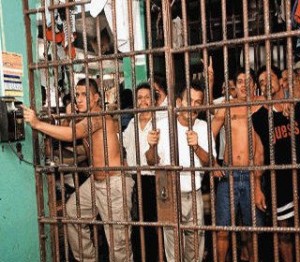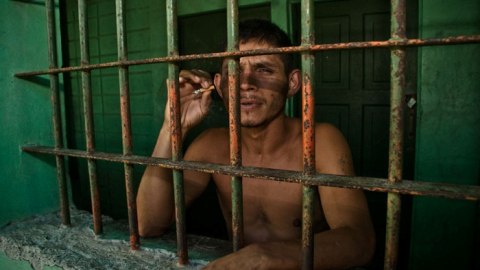Costa Rica News – When going through the news in Costa Rica this morning I came across a story about how in an effort to reduce overcrowding in prisons, the Costa Rican government is considering a plan that would release some 4,000 inmates to the street, with an electronic bracelet to monitor their movements. Let’s count the ways this is not going to work.
 That plan, developed with input from the Ministry of Defense and Justice and Peace, is currently in debate in the legislature.
That plan, developed with input from the Ministry of Defense and Justice and Peace, is currently in debate in the legislature.
The Draft Law on Electronic Monitoring Mechanisms in Criminal Matters, record N ° 17,665 , aims to regulate the use of electronic tagging as an alternative to custody or as a substitute for a custodial sentence.
The bracelet is a mobile device, like a watch, that attaches to the wrist or ankle of the person, whose movements are tracked by a satellite that transmits signals to the control center.
Thus, if a house arrest fails or if the person circulating in a restricted area established to stay away from the victim, the device sounds an alert to the police.
Who they are thinking of releasing:
- Prison terms of 6 years or less (Pretty much everyone then, as it takes a pretty bad crime to be sentenced more than that)
- Women sentenced to six years in prison, with children under 18
- Pregnant women or with children under 24 months of age
- Prisoners with physical, mental or addictive, and cases of disease that can not be treated in prison
*To date, according to Justice, the number of women in prison who have children under is 510
Not Going to Work – Costa Rica will have to instate a system that is efficient to track these prisoners. Honestly, what is the chance of that? The person being paid $2 an hour to watch these prisoners will have to know see when the bracelet sends off an alert. Then that person will have to then notify the local police. Then the local police will have to move quickly to go arrest this person. With bribes and corruption as well as the slow moving on non-acting local police, how does this plan come close to working?
This is another example of Costa Rica trying to be more like the USA as well as trying to put a Band-aid on a broken leg. I agree with the thought to release prisoners for good behavior with probation officers and a system in place that is quick to react if there is a violation by one of these released inmates. However, that is not the case in Costa Rica. There is nothing efficient or quick acting when it comes to law enforcement. Bribes and corruption are at every level and this idea is destined to fail. Unless the proper logistics are in place in many cases this will just be releasing criminals to the street to commit more crimes.
Fix the Problem – No one is denying that overcrowding in the Costa Rican prison system is not a problem. Let’s look at the causes of this problem: (These are just a few)
- The inefficient court and legal system
- A high cost of living and low wages for the general public (committing crimes to survive)
- Police and law enforcement corruption with no accountability
- Low police wages
Costa Rica why don’t you fix the causes of the prison overcrowding instead of causing another one?


1 comment
Mr. Stevens,
If Costa Rica takes effective action to “fix the causes of the prison overcrowding” it will not be an example of “Costa Rica trying to be more like the USA.” You have bravely chronicled your history of substance abuse which is a medical problem. In the U.S.A., instead of spending money on large scale drug treatment programs the U.S.A. is in the big business of building prisons within which those with substance abuse illness are warehoused…not effectively treated. Also, while federal and state government actions during the last 4 years have jump started a slow economic recovery that has begun to provide significant numbers of jobs so that people do not have to turn to crime to survive, recent inaction by the House of Representatives has brought about a drastic reduction in all federal programs which will eliminate hundreds of thousands jobs in both the public and the private sectors.
Just one statistic tells the story of the U.S.A.’s approach to the causes of crime. With only FIVE PERCENT of the world population, the U.S.A. has TWENTY PERCENT of its prisoners. This is because the country’s incarceration rate has close to quintupled since the early 1970s. About TWO MILLION Americans currently live behind bars in local jails, state and federal prisons. In other words, the U.S.A. does very little to mitigate the causes of crime. There are a few small programs in the U.S.A. that release prisoners using the electronic tracking devices. However, in the vast majority of criminal convictions the position of the courts is, if you do the crime, you do the time. Of course, like in C.R., if you are rich enough to hire good lawyers then even if you are convicted, you will likely do no time or only have a short sentence in a so-called prison that is more like a good motel. And the rich guys who do get a conviction are a very small proportion of the total inmate population. Some of my cousins are, or have been, part of the U.S. legal system, one of them being a senior circuit judge on the U.S. Court of Appeals for the Ninth Circuit. During their careers, they have all been deluged by enormous numbers of people accused of crimes because of the types of laws that exist in the U.S.A. that criminalize some types of behavior that should actually be treated as illness or not even as criminal actions.